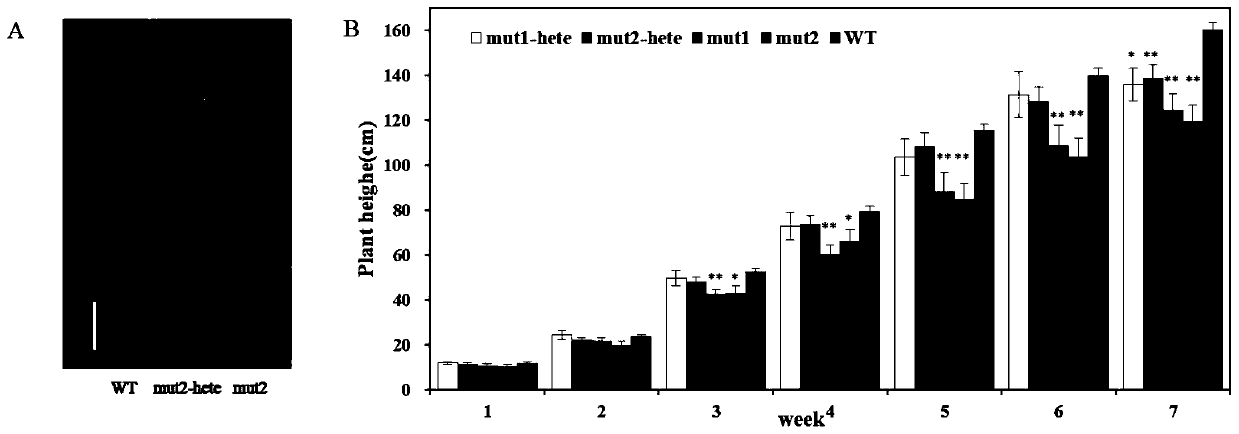Method of developing corn dwarfing material via gene editing
A gene editing, corn technology, applied in the fields of biotechnology and genetic breeding, can solve the problems of reduced yield, lodging, and incomplete application of corn breeding
- Summary
- Abstract
- Description
- Claims
- Application Information
AI Technical Summary
Problems solved by technology
Method used
Image
Examples
Embodiment 1
[0028] Example 1 Design of editing sites based on CRISPR / Cas9
[0029] Design target sites through CRISPR-P (http: / / crispr.hzau.edu.cn / CRISPR2 / ) website, maize target genes ZmGA20ox3, ZmGA20ox5 and related information from the database MaizeGDB (https: / / www.maizegdb.org / ) download. Upload the exon sequence of the target gene to the CRISPR-P website, select the reference genome as the maize genome, and obtain potential editing sites near 5'-NGG. Two target sites are designed for each gene and located on the first exon of the gene, and the two target sites (located in different expression cassettes) are connected in series to the same gene editing vector. ZmGA20ox3 target site sequence is 5’-GGAGCCATTCCTGTGGCCGC-3’ and 5’-CTGTCCTTCGGCTTCCACGA-3’, ZmGA20ox5 target site sequence is 5’-AGATCCCCGCGCCATTCCTG-3’ and 5’-CTGTCGTTCGGCTACCACGA-3’,
Embodiment 2
[0030] Example 2 Construction of Gene Editing Vectors
[0031] Primers were designed according to the selected editing sites and the restriction sites at the multiple cloning sites of vectors pCBC-MT1T2 and pBUE411. The primer information is shown in Table 1:
[0032] Table 1 Amplification Primers
[0033]
[0034]
[0035] Use two rounds of PCR to amplify the target fragment. The first round of PCR reaction uses the first pair of primers MT1-F0 / MT2-R0 to amplify the pCBC-MT1T2 plasmid as a template, and the second round of PCR reaction uses the second pair of primers MT1-BsF / MT2-BsR uses the first-round amplification product as a template to amplify, connects the two target sites in series, and obtains the target fragment.
[0036] The first round reaction system is:
[0037]
[0038] The second round reaction system is:
[0039]
[0040] The two-round PCR amplification reaction program was: 94°C for 2min; 98°C for 10s, 58°C for 30s, 68°C for 1min, 35 cycles; ...
Embodiment 3
[0050] Example 3 Gene Editing Vector Transformed into Agrobacterium LBA4404
[0051] The gene ZmGA20ox3 and ZmGA20ox5 editing vectors constructed in Example 2 were respectively transformed into Agrobacterium LBA4404, and the specific steps were as follows:
[0052] (1) Take 5 μL of the plasmid and add it to 200 μL of Agrobacterium competent cells;
[0053] (2) Ice bath for 30 minutes;
[0054] (3) Take it out from the ice, and quickly place it in liquid nitrogen for quick freezing for 5 minutes;
[0055] (4) Take it out from the liquid nitrogen and incubate in a water bath at 37°C for 5 minutes;
[0056] (5) Take it out and put it on ice for 5 minutes;
[0057] (6) Add 800 μL of blank YEB medium, and recover on a shaker at 28°C at 200 rpm for 4-5 hours;
[0058] (7) 4000rpm normal temperature centrifugation for 5min;
[0059] (8) Discard part of the supernatant, and suspend the precipitate with the remaining about 200 μL supernatant, spread it on a YEB solid culture plate...
PUM
 Login to View More
Login to View More Abstract
Description
Claims
Application Information
 Login to View More
Login to View More - R&D
- Intellectual Property
- Life Sciences
- Materials
- Tech Scout
- Unparalleled Data Quality
- Higher Quality Content
- 60% Fewer Hallucinations
Browse by: Latest US Patents, China's latest patents, Technical Efficacy Thesaurus, Application Domain, Technology Topic, Popular Technical Reports.
© 2025 PatSnap. All rights reserved.Legal|Privacy policy|Modern Slavery Act Transparency Statement|Sitemap|About US| Contact US: help@patsnap.com



